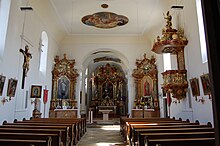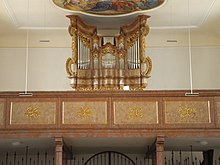Assumption of Mary (Böhmischbruck)
The Roman Catholic parish church of the Assumption of Mary is located in the village of Böhmischbruck , which today belongs to the Upper Palatinate town of Vohenstrauß . It is in Propsteistraße 13.
history
The foundation of the church is closely related to the hospital in this place, operated by beguines and begarians , with which travelers on the Golden Road were cared for; the hospital has been attested since 1251. There is also a close connection with the creation of the Propstei Böhmischbruck . The Dominican Ernst, Bishop of Pomesanien (Prutinensis), on January 1st, 1251, promised all those who supported the master and the brothers of Böhmischbruck with the construction of St. Mary's Church an indulgence of 40 and 100 days. Pope Alexander IV also granted the rector of the Church of Böhmischbruck an indulgence of 40 days for visitors to the church on certain holidays. The Marienkirche was inaugurated around May 11, 1259. This was initially a branch church of the Moosbach parish . The elevation to its own parish took place after 1299, after the Predium Böhmischbruck had come to the St. Emmeram monastery in Regensburg. From this time until the secularization , the parish of Böhmischbruck was cared for by Benedictine monks from the monastery. Böhmischbruck appears as a separate parish in the oldest parish register of the Diocese of Regensburg from 1326. In 1480 the parish of Böhmischbruck was incorporated into the St. Emmeram monastery.
During the Hussite Wars , the church was raided and looted in 1423, 1427 and 1431. In addition, on May 5, 1552, the church and rectory were largely destroyed by fire. Already in 1542 the population had become Calvinist , since the place belonged to the Electoral Palatinate at that time . The reconstruction seems to have been delayed, because in 1577 the Calvinist provost Johann Otto asked for permission to build the church. In 1629 the re-Catholicization was carried out.
In 1782 the parish of Böhmischbruck also included Etzgersrieth , Rückersrieth , Netherland , Uchamühle , Ober waltenrieth , Kößing , Altentreswitz , Ödpielmannsberg , Grünhammer and Linglmühle .
Since the parish no longer has its own pastor since June 1984, the pastor von Vohenstrauß was appointed parish administrator. Today Böhmischbruck forms a parish community with Vohenstrauss. The last pastor of Böhmischbruck was Prelate Josef Ascherl.
Church building
The church has a nave with a retracted choir. The oldest parts of the church are Gothic . If you look at the church building from the east, you can see five double-stepped Gothic struts on the outside of the choir . The retracted choir and a pointed arch window are also Gothic . The church was redesigned several times during the Baroque period in 1730 and 1740.
In 1912, a dome on copper sheet was placed on the hexagonal church tower , on which there is a triple cross, with which the religious division and the reintroduction of the Catholic faith are remembered. In 1995 the outside of the church was renovated, and the inside was renovated in 1996/67. A discovered Gothic window in the nave was plastered over again. As a building finding it could be confirmed that the church was made one meter higher in the baroque period. The roof was re-covered with plain tiles. The red onion was given a new covering; a new church tower clock was also installed. The church and parsonage were painted light yellow. A visitor grille was made over the entire width of the entrance area.
Interior design
The high altar with four columns and pilasters dates from the early Rococo (1730–1740). The altarpiece shows the church's patronage , the Assumption of Mary . Ten medallions with motifs from the Song of Songs and the biblical books of wisdom frame the picture. In the extract there is a Maria with the child , also from the early 18th century.
The left side altar shows the image of St. Nepomuk . As a special feature, it has seven instead of the usual five stars. The right side altar shows St. Sebastian .
The Baroque pulpit has filigree and gold leaf combined carvings on. The Regensburg bishop and martyr St. Emmeram is written on the cover . The pulpit was renovated in 1998.
On the left side of the church there is also the baptismal font , which was created between 1740/1750. With its two hemispheres it is reminiscent of a Romanesque baptismal font. The baptism of Christ by John is depicted on the upper basin .
There are 14 stations of the cross on the side walls of the church . The church is also decorated with a large number of putti ("children without an altar").
On the left side of the wall is an epitaph made of quartz stone by Agnes Sauerzapf from the Altentreswitz line from 1592 with the transfiguration of Christ as a symbol for the resurrection . Remnants of the earlier painting are still preserved.
The ceiling pictures represent biblical reports of the Annunciation and the Visitation . The pictures of the choir room (e.g. flag of the warrior club, guardian girl with goose herd) date from around 1919 and were painted by the painter Leonhard Thoma .
In the sacristy there was a Gothic cross that was placed inside the church after the sacristy was demolished.
organ
The organ is reminiscent of the works of the Nabburg organ builder Andreas Weiß , although there is no definite evidence of this origin. Only the baroque case of the old organ still exists, not the original sound mechanism.
In 1904 a pneumatic organ with nine registers from the organ building company Martin Binder & Sohn from Regensburg was installed. In 2009, with advice from Norbert Düchtel, a new building was carried out by the company Rudolf Kubak from Augsburg (16 / II / P, Zimbelstern ), the prospectus was retained. The organ was inaugurated on June 1, 2009 by Auxiliary Bishop Reinhard Pappenberger .
Bells
During the Second World War , three of the original four bells were removed in April 1943. One of them was found in a Hamburg port after the war and brought back to Böhmischbruck.
Today the church is again equipped with four bells. The largest weighs 630 kg, it was cast on the tone f sharp by the bell foundry Hamm in Regensburg . It is dedicated to John the Baptist and is labeled “Prepare the way of the Lord”. The next largest weighs 380 kg and is tuned to tone a . It was cast by the Spannagl company in Regensburg and was the only one to get stuck in the Second World War. The third bell weighs 310 kg, was cast in 1950 and was donated by the Böhmischbruck parish for the Holy Year ; it sounds in memory of the Incarnation of Christ. The fourth bell is the death bell ; it weighs 40 kg and is tuned to c sharp . It was also cast at the Spannagl bell foundry. It was the bell that returned to Böhmischbruck from the Hamburg Glockenhafen on February 6, 1948; she bears the image of St. Joseph with a blooming lily, her crown is formed by six winged seraphim .
literature
- Buchbinder, Gabriele: Böhmischbrucker Almanach: 1251–2001; History & stories for the 750th anniversary of the founding of the church. Böhmischbruck, Publisher: Pfarrei Böhmischbruck 2001.
Web links
Individual evidence
- ↑ find means database of the main and Bavarian State Archive (St. Emmeram Kloster documents 78/1)
- ↑ Finding aid database of the Bavarian Main and State Archives (St. Emmeram Monastery Regensburg documents 100)
- ↑ Dieter Bernd: Vohenstrauss . In: Historical Atlas of Bavaria , part of Old Bavaria . Series I, issue 39. Komm. Für Bayerische Landesgeschichte, Munich 1977, ISBN 3-7696-9900-9 , p. 70 f . ( Digitized version ).
- ↑ Andreas Weiß: The organs in the churches of the large community Vohenstrauss. In church guides to churches and chapels in the city and large parish Vohenstrauss. (= Streifzüge - contributions to local history and local history of the city and large community Vohenstrauß and the surrounding area, 15th year, 2000, issue 22 ), p. 83.
- ↑ New organs in the diocese of Regensburg Böhmischbruck
Coordinates: 49 ° 34 ′ 30.9 ″ N , 12 ° 21 ′ 12.3 ″ E




